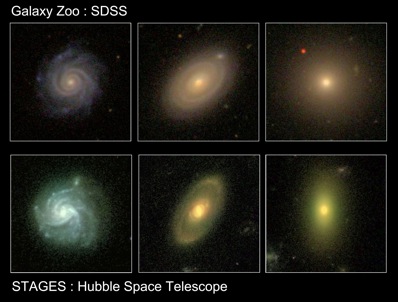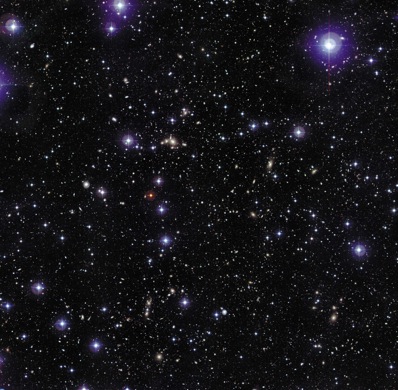UK astronomers working on data from two separate projects - Galaxy Zoo and the Space Telescope A901/902 Galaxy Evolution Survey (STAGES) - have both uncovered a type of galaxy that represents a missing link in galaxy evolution.
Astronomers broadly divide galaxies into two categories according to their shape: either disc-like systems like our own Milky Way which exhibits spiral arms, or round, rugby-ball shaped collections of stars known as ellipticals. In most cases, a galaxy's shape matches its colour: spiral galaxies appear blue because they are still vigorously forming hot young stars, while elliptical galaxies are mostly old, dead and red, and tend to cluster together in crowded regions of space.
But new results, based on two independent studies, reveal a population of unusual spiral galaxies that appear red. "In order to have spiral arms, they must have been normal, blue, spiral galaxies up until fairly recently,” says Dr Steven Bamford of the University of Nottingham who led the Galaxy Zoo study. “But for some reason their star formation has been stopped, and they have turned red. Whatever caused them to stop forming stars can't have been particularly violent, or it would have destroyed the delicate spiral pattern."

These images of three galaxies from the Galaxy Zoo (top) and STAGES surveys (bottom) show examples of how the newly discovered population of red spiral galaxies on the outskirts of crowded regions in the Universe may be a missing link in our understanding of galaxy evolution. The left hand galaxies show young blue spiral galaxies and the right are examples of elliptical galaxies containing old, red stars. The central images show the new class of red spiral galaxy, thought to be changing from blue spirals into red as star formation has been shut off by interactions with the environment. Image: Hubble Space Telescope/COMBO-17 survey/Marco Barden, Christian Wolf, Meghan Gray (STAGES) & Sloan Digital Sky Survey (Galaxy Zoo).
While Galaxy Zoo looked at the gross properties of millions of
galaxies across a large area of sky, the STAGES project examined in detail the types of neighbourhood where transformations between the two types of galaxies are expected to occur, such as the A901/902 supercluster of spiral galaxies. Using the Hubble and Spitzer Space Telescopes, the STAGES team uncovered a surprisingly large population of red spiral galaxies.
"For the STAGES galaxies, the Spitzer Space Telescope provided us with additional images at infrared wavelengths,” says STAGES scientist Dr Christian Wolf of the University of Oxford. “With them, we were able to go further and peer through the dust to find the missing piece of the puzzle". Wolf discovered that the red spirals were hiding low levels of hidden star formation, despite their otherwise lifeless appearance in visible light.
Astronomers have used the complementary observations to come up with a new theory of how nature and nurture have both played a significant role in these galaxies’ evolution. They suggest that star formation in blue spiral galaxies is gradually shut off and hidden behind dust, before slowly smoothing out to form lens-shaped red galaxies with no trace of spiral arms. To directly transform the galaxy into an elliptical would require collisions of galaxies.
The local environment of the galaxy also turns out to be important in determining when and how quickly its star formation is shut down. The red spirals are found primarily on the outskirts of crowded regions of space where galaxies cluster together. As a blue galaxy is drawn into the cluster by gravity, an interaction with its environment causes a slow-down in star formation. The astronomers see that the further in a galaxy is, the more it is affected by its environment.

The Abell 901/902 supercluster as seen by COMBO-17 in the STAGES survey. This complex system provides an ideal laboratory for studying the links between environment and galaxy evolution. Image: STAGES/COMBO-17/HST.
But if environment decides where the process occurs, the two teams also found that the mass of the galaxy decides how quickly it takes place. "Just as a heavyweight fighter can withstand a blow that would bring a normal person to his knees; a big galaxy is more resistant to being messed around by its local environment,” explains Galaxy Zoo team member Professor Bob Nichol of Portsmouth University. “Therefore, the red spirals that we see tend to be the larger galaxies - presumably because the smaller ones are transformed more quickly."
The next step for both teams is to find out exactly what shuts off the star formation, by looking inside the galaxies themselves. One suspect behind the slow demise of galaxies is a process known as strangulation, in which a galaxy's fuel supply is stripped away as it encounters a crowd of galaxies. Starved of the raw material needed to form new stars, it will slowly change colour from blue to red as its existing stars age.
"These results are possible thanks to a major scientific
contribution from our many volunteer armchair astronomers,” says Galaxy Zoo team leader Chris Lintott. “No group of professionals could have classified this many galaxies alone.”
The original Galaxy Zoo launched in the summer of 2007 and saw over 150,000 visitors classify one million galaxies, resulting in enough data to fill some six scientific papers. Galaxy Zoo 2 is currently being prepared to answer more detailed questions about the morphologies of around 250,000 galaxies from the original survey in order to compile the most comprehensive data set of galaxy shapes yet.
from:http://astronomynow.com/081126galaxyevolutionnatureornurture.html





 RSS Feed (xml)
RSS Feed (xml)